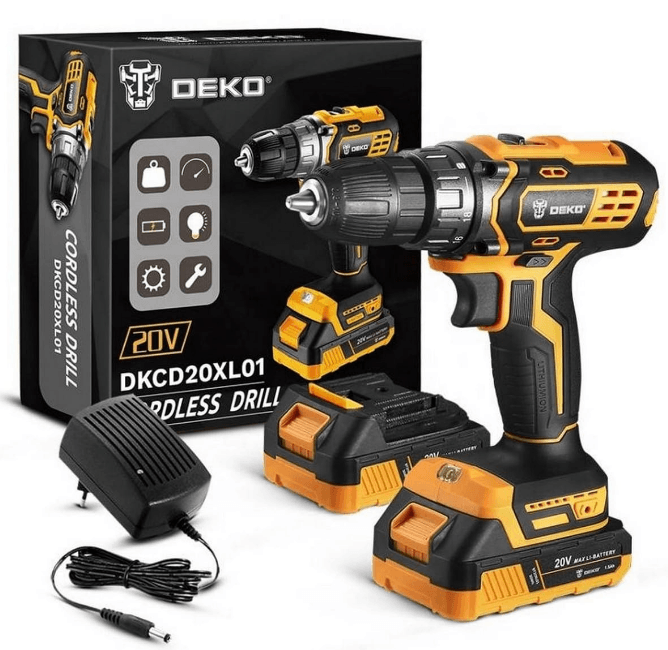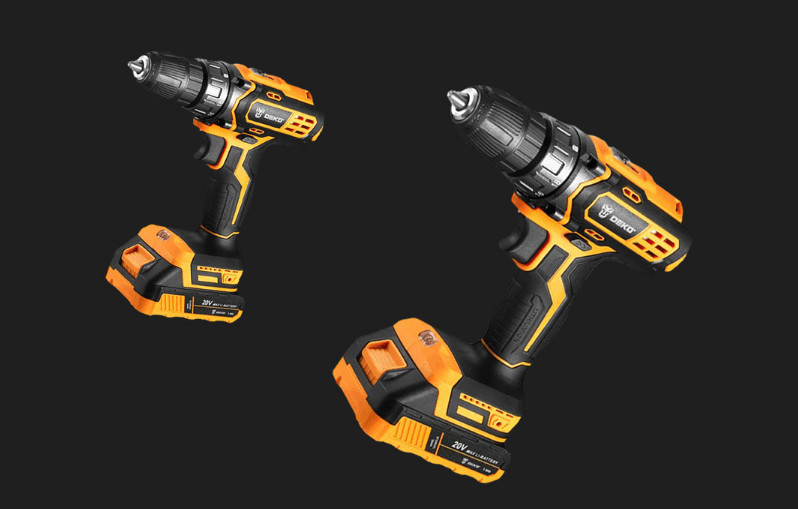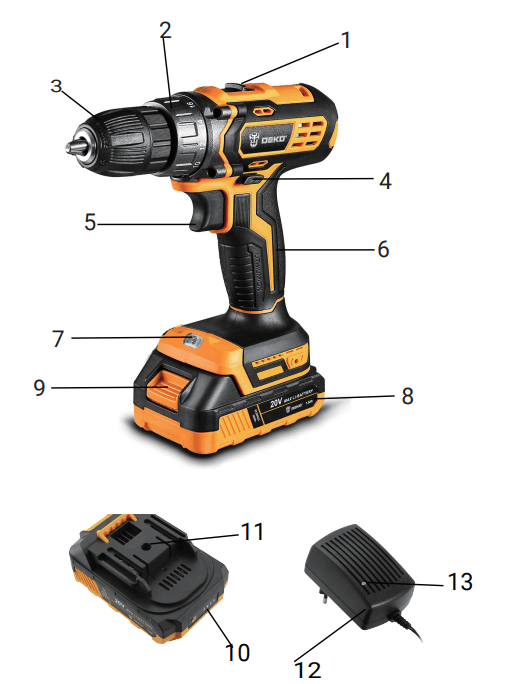
Deko Tools DKCD20XL01 Cordless Drill

General Power Tool Safety Warnings
WARNING: Read all safety warnings, instructions, illustrations, and specifications provided with this power tool. Failure to follow all instructions listed below may result in electric shock, fire and/or serious injury. Save all warnings and instructions for future reference. The term “power tool” in the warnings refers to your mains-operated (corded) power tool or battery-operated (cordless) power tool.
- Work area safety
- Keep the work area clean and well lit. Cluttered or dark areas invite accidents.
- Do not operate power tools in explosive atmospheres, such as in the presence of flammable liquids, gases or dust. Power tools create sparks, which may ignite the dust or fumes.
- Keep children and bystanders away while operating a power tool. Distractions can cause you to ose control.
- Electrical safety
- Power tool plugs must match the outlet. Never modify the plug in any way. Do not use any adapter plugs with earthed (grounded) power tools. Unmodified plugs and matching outlets will reduce the risk of electric shock.
- Avoid body contact with earthed or grounded surfaces, such as pipes, radiators, ranges, and refrigerators. There is an increased risk of electric shock if your body is earthed or grounded.
- Do not expose power tools to rain or wet conditions. Water entering a power tool will increase the risk of an electric shock.
- Do not abuse the cord. Never use the cord for carrying, pulling, or unplugging the power tool. Keep the cord away from heat, oil, sharp edges, or moving parts. Damaged or entangled cords increase the risk of electric shock.
- When operating a power tool outdoors, use an extension cord suitable for outdoor use. Use of a cord suitable for outdoor use reduces the risk of electric shock.
- If operating a power tool in a damp location is unavoidable, use a residual current device (RCD) protected supply. Use of an RCD reduces the risk of electric shock.
- Personal safety
- Stay alert, watch what you are doing, and use common sense when operating a power tool. Do not use a power tool while you are tired or under the influence of drugs, alcohol, or medication. A moment of inattention while operating power tools may result in serious personal injury.
- Use personal protective equipment. Always wear eye protection. Protective equipment such as a dust mask, non-skid safety shoes, a hard hat, or hearing protection used for appropriate conditions will reduce personal injuries.
- Prevent unintentional starting. Ensure the switch is in the off-position before connecting to the power source and/or battery pack, picking up or carrying the tool. Carrying power tools with your finger on the switch or energising power tools that have the switch on invites accidents.
- Remove any adjusting key or wrench before turning the power tool on. A wrench or a key left Being attached to a rotating part of the power tool may result in personal injury.
- Do not overreach. Keep proper footing and balance at all times. This enables better control of the power tool in unexpected situations.
- Dress properly. Do not wear loose clothing or jewellery. Keep your hair and clothing away from moving parts. Loose clothes, jewellery or long hair can be caught in moving parts.
- If devices are provided for the connection of dust extraction and collection facilities, ensure these are connected and properly used. Use of dust collection can reduce dust-related hazards.
- Do not let familiarity gained from frequent use of tools allow you to become complacent and ignore tool safety principles. A careless action can cause severe injury within a fraction of a second.
- Power tool use and care
- Do not force the power tool. Use the correct power tool for your application. The correct power tool will do the job better and safer at the rate for which it was designed
- Do not use the power tool if the switch does not turn it on and off. Any power tool that cannot be controlled with the switch is dangerous and must be repaired.
- Disconnect the plug from the power source and/or remove the battery pack, if detachable, from the power tool before making any adjustments, changing accessories, or storing power tools. Such preventive safety measures reduce the risk of starting the power tool accidentally.
- Store idle power tools out of the reach of children and do not allow persons unfamiliar with the power tool or these instructions to operate the power tool. Power tools are dangerous in the hands of untrained users.
- Maintain power tools and accessories. Check for misalignment or binding of moving parts, breakage of parts and any other condition that may affect the power tool’s operation. If damaged, have the power tool repaired before use. Many accidents are caused by poorly maintained power tools.
- Keep cutting tools sharp and clean. Properly maintained cutting tools with sharp cutting edges are less likely to bind and are easier to control.
- Use the power tool, accessories and tool bits etc. in accordance with these instructions, taking into account the working conditions and the work to be performed. Use of the power tool for operations different from those intended could result in a hazardous situation.
- Keep handles and grasping surfaces dry, clean and free from oil and grease. Slippery handles and grasping surfaces do not allow for safe handling and control of the tool in unexpected situations.
- Battery tool use and care.
- Recharge only with the charger specified by the manufacturer. A charger that is suitable for one type of battery pack may create a risk of fire when used with another battery pack.
- Use power tools only with specifically designated battery packs. Use of any other battery packs may create a risk of injury and fire.
- When battery pack is not in use, keep it away from other metal objects, like paper clips, coins, keys, nails, screws or other small metal objects, that can make a connection from one terminal to another. Shorting the battery terminals together may cause burns or a fire.
- Under abusive conditions, liquid may be ejected from the battery; avoid contact. If contact accidentally occurs, flush with water. If liquid contacts the eyes, additionally, seek medical help. Liquid ejected from the battery may cause irritation or burns.
- Do not use a battery pack or tool that is damaged or modified. Damaged or modified batteries may exhibit unpredictable behaviour, resulting in fire, explosion or risk of injury.
- Do not expose a battery pack or tool to fire or excessive temperature. Exposure to fire or temperature above 40 °C may cause an explosion.
- Follow all charging instructions and do not charge the battery pack or tool outside the temperature range specified in the instructions. Charging improperly or at temperatures outside the specified range may damage the battery and increase the risk of fire.
- Service
- Have your power tool serviced by a qualified repair person using only identical replacement parts. This will ensure the safety of the power tool.
- Never service damaged battery packs. Service of battery packs should only be performed by the manufacturer or authorized service providers.
Production Specification

Parts Description
- 2-speed gear switch
- Torque adjustment ring
- 10mm(3/8”) keyless chuck
- Forward/reverse switch
- Speed on/off control trigger
- Handle
- LED worklight
- Battery pack
- Battery pack release button
- Battery indicator
- Charging input port.
- Adapter/Charger
- Indicator light Red light— in charge Green light- fully charged

Intended Use
The machine is intended for driving in and loosening screws as well as for drilling in wood, metal, ceramics and plastic. DO NOT use under wet conditions or in the presence of flammable liquids or gases. DO NOT let children come into contact with the tool. Supervision is required when inexperienced operators use this tool.
Variable Speed Control Trigger
To turn the tool on, squeeze the speed on/off control trigger (5). To turn the tool off, release the trigger. The chuck will stop as soon as the trigger (5) is fully released.
NOTE: Continuous use in the variable speed range is not recommended. It may damage the switch and should be avoided.
Forward/Reverse Switch
A forward/reverse switch (4) determines the direction of the tool and also serves as a lock-off button. To select forward rotation, release the switch and depress the forward/reverse control button on the right side of the tool. To select reverse, release the switch and depress the forward/reverse control button on the left side of the tool. The center position of the control button locks the tool in the OFF position. When changing the Position of the control button, be sure the switch is released.
Torque Adjustment Ring (18+1 Torque Settings)
Your tool has an electronic adjustable torque screwdriver system for driving and removing a wide range of fasteners. Circling the torque adjustment ring (2) are numbers and a drill bit symbol. These numbers are used to set the ring to deliver a torque range. The higher the number on the ring, the higher the torque and the larger the fastener that can be driven. To select any of the numbers, rotate until the desired number aligns with the arrow.
2-Speed Gear Switch
The 2-speed feature of your tool allows you to shift gears for greater versatility. To select speed 1 (highest torque setting), turn the tool off and permit it to stop. Slide the gear switch (1) all the way forward to speed 2(highest speed setting).
WARNING: Do not change speed when the tool is running. Always allow the drill to come to a complete stop before changing speeds.
Keyless Chuck
WARNING: Always lock off the trigger switch and disconnect the tool from the power source when changing accessories.
WARNING: Always ensure the bit is secure before starting the tool. A loose bit may eject from the tool, causing possible personal injury.
Your tool features a double-sleeve keyless chuck (3). To insert a drill bit or other accessory, follow these steps.
- Turn the tool off and disconnect the tool from the power source.
- Hold the sleeve A to secure the chuck with one hand and grasp sleeve B with the other hand to change the accessory. Rotate the sleeve counterclockwise (as viewed from the front) far enough to accept the desired accessory.
- Insert the accessory into the chuck and tighten securely by rotating the sleeve A clockwise.

LED Worklight
This drill features an LED worklight (7). This LED worklight (7) could automatically be turned on when the speed control trigger is squeezed.
WARNING: The light of this power tool is intended to illuminate the power tool’s direct area of working operation and is not suitable for household room illumination.
Installing and Removing the Battery Pack
NOTE: For best results, make sure your battery pack is fully charged. To install the battery pack (8) into the tool handle, align the battery pack with the rails inside the tool’s handle and slide it into the handle until the battery pack is firmly seated in the tool and ensure that it does not disengage. To remove the battery pack from the tool, press the release button (9) and firmly pull the battery pack out of the tool handle.
Battery charging
Note: The battery is supplied partially charged to prevent possible problems. Therefore, you should charge it prior to use. Batteries will not reach full charge the first time they are charged. Allow several charging/discharging cycles for them to fully charge.
WARNING: Do not continue to press the On/Off switch after the machine has been automatically switched off. The battery can be damaged. The battery is equipped with an NTC temperature control, which allows charging only within a temperature range of between 10°C-40°C(50°F-104°F). A long battery service life is achieved in this manner. Observe the notes for disposal.
Use only the original DEKO battery in conjunction with your DEKO power tool. This measure alone protects the battery against dangerous overload. When using other batteries, imitations, reconditioned batteries, or other brands, there is the danger of injury as well as property damage from exploding batteries. Do not open the battery. The danger of short-circuiting may occur. Protect the battery against heat, e.g., against continuous intense sunlight, fire, water, and moisture. The danger of an explosion may occur.
Screw Driving
- Select the desired speed/torque range using the gear switch (1) to match the speed and torque to the planned operation.
- Turn the torque adjustment ring (2) to the desired position.
NOTE: Use the lowest torque setting required to seat the fastener at the desired depth. The lower the number, the lower the torque output. - Insert the desired fastener accessory into the chuck.
- Make some practice runs in scrap or on unseen areas of the workpiece to determine the proper position of the torque adjustment ring.
- Always start with lower torque settings, then advance to higher torque settings to avoid damage to the workpiece or fastener.
Drilling
NOTE: If drilling thin material, use a wood “back-up” block to prevent damage to the material.
- Select the desired speed/torque range using the gear switch (1) to match the speed and torque to the planned operation. Turn the torque adjustment ring (2) to the drill symbol.
- Always choose appropriate drill bits for different materials.
- Always apply pressure in a straight line with the bit. Use enough pressure to keep the drill biting, but do not push hard enough to stall the motor or deflect the bit.
- Hold the tool firmly with both hands to control the twisting action of the drill.
WARNING: Drill may stall if overloaded, causing a sudden twist. Always expect the stall. Grip the drill firmly to control the twisting action and avoid injury. - IF DRILL STALLS, it is usually because it is being overloaded or improperly used. RELEASE TRIGGER IMMEDIATELY, remove the drill bit from work, and determine the cause of stalling. DO NOT DEPRESS THE TRIGGER ON AND OFF IN AN ATTEMPT TO START A STALLED DRILL — THIS CAN DAMAGE THE DRILL.
- To minimize stalling or breaking through the material, reduce pressure on the drill and ease the bit through the last fractional part of the hole.
- Keep the motor running when pulling the bit back out of a drilled hole. This will help prevent jamming.
Residual risks
Even when the tool is used as prescribed, it is not possible to eliminate all residual risk factors. The following hazards may arise in connection with the tool’s construction and design:
- Damage to the lungs can occur if an effective dust mask is not worn.
- Damage to hearing if effective hearing protection is not worn.
- Health defects resulting from vibration emission if the power tool is being used over a longer period of time or not adequately managed and properly maintained.
Maintenance and Cleaning
Before any work on the machine (e.g., maintenance, tool change, etc.), as well as during transport and storage, set the rotational direction switch to the center position.Unintentional actuation of the On/Off switch can lead to injuries. For safe and proper working, always keep the machine and ventilation slots clean. To ensure product SAFETY and RELIABILITY, repairs and any other maintenance or adjustments should be performed by a qualified repair person, always using DEKO replacement parts.
Service Information
We provide a 1-year quality warranty from the purchase date and friendly customer service. Our after-sales service responds to your questions concerning the maintenance and repair of our product as well as spare parts. Please contact your local distributor or send emails to services@dekotools.com
Transport
The contained lithium-ion batteries are subject to the Dangerous Goods Legislation requirements. The user can transport the batteries by road without further requirements. Dispatch batteries only when the housing is undamaged. When being transported by third parties (e.g., air transport or forwarding agency), special requirements on packaging and labeling must be observed. For the preparation of the item being shipped, please observe possibly more detailed national regulations
and consult an expert for hazardous materials. The machine, rechargeable batteries, accessories, and packaging should be sorted for environmentally friendly recycling. Do not dispose of power tools and batteries/rechargeable batteries into household waste! Please recycle them at the collection points provided for the purpose. Ask your local authority for information about recycling.
For more manuals by Deko Tools, visit ManualsLibraryy



